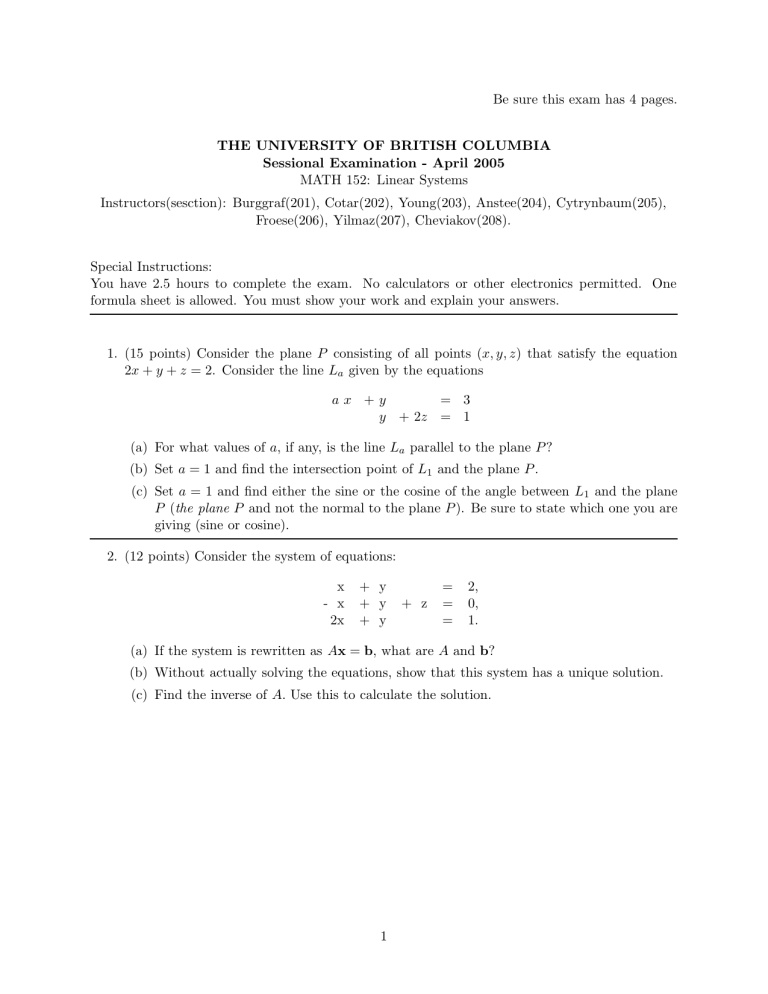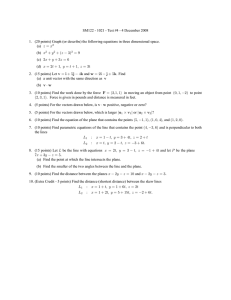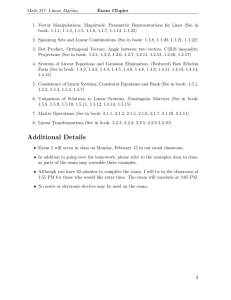Be sure this exam has 4 pages. MATH 152: Linear Systems

Be sure this exam has 4 pages.
THE UNIVERSITY OF BRITISH COLUMBIA
Sessional Examination - April 2005
MATH 152: Linear Systems
Instructors(sesction): Burggraf(201), Cotar(202), Young(203), Anstee(204), Cytrynbaum(205),
Froese(206), Yilmaz(207), Cheviakov(208).
Special Instructions:
You have 2.5 hours to complete the exam. No calculators or other electronics permitted. One formula sheet is allowed. You must show your work and explain your answers.
1. (15 points) Consider the plane P consisting of all points ( x, y, z ) that satisfy the equation
2 x + y + z = 2. Consider the line L a given by the equations a x + y = 3 y + 2 z = 1
(a) For what values of a , if any, is the line L a parallel to the plane P ?
(b) Set a = 1 and find the intersection point of L
1 and the plane P .
(c) Set a = 1 and find either the sine or the cosine of the angle between L
1 and the plane
P ( the plane P and not the normal to the plane P ). Be sure to state which one you are giving (sine or cosine).
2. (12 points) Consider the system of equations: x + y = 2,
- x + y + z = 0,
2x + y = 1.
(a) If the system is rewritten as A x = b , what are A and b ?
(b) Without actually solving the equations, show that this system has a unique solution.
(c) Find the inverse of A.
Use this to calculate the solution.
1
3. (10 points) Ryan is trying to determine the location of his house on the map in Figure 1.
Suppose that from his house, Grouse Mountain, located at (5 , 11), and Mount Seymour, located at (14 , 10), appear to be in the direction of the vectors v
GM
=
−
1
4
, v
M S
=
1
1 respectively. In both these vectors, the first component corresponds to the east-west coordinate (east is positive) and the second corresponds to the north-south coordinate (north is positive). Calculate the coordinates of Ryan’s house.
Grouse Mountain
Mount Seymour
10
5
0
0 5 10 15
Figure 1: Map for problem 3.
4. (13 points) Consider a system of equations
− x + y + 10 w = 0
− y + 7 z
−
2 w = 0 ,
,
2 y + z + w = 0 ,
−
3 y + z
−
2 w = 0 .
(a) Is this system homogeneous or inhomogeneous?
(b) Find all solutions to this system.
(c) Using your answer to (b), solve the system of equations
- x + y
- y + 7z
2y + z
- 3y + z
+ 10w = 3,
- 2w = 0,
+ w = 0,
- 2w = 0.
5. (10 points) Find the eigenvectors and eigenvalues for the following matrix. Note that 1 is an eigenvalue.
A =
1 0 2
−
1 1 1
2 0 1
2
6. (10 points) Determine all possible values of p and q for which the following system
4
−
1 p q 2 6 has
(a) no solutions,
(b) exactly one solution,
(c) infinitely many solutions.
(d) Give the general solution to the system in vector parametric form for the values of p and q determined in part c.
7. (15 points) Suppose that R is a linear transformation acting on vectors [ x y z ]
T satisfies
R
1
0
=
0
1
, R
0
1
=
0
0
, R
0
0
=
1
0
.
0 0 0
Let S be the linear transformation that keeps
0
0
1
1 fixed, that is, S
0
0
0
= and which
0
0
, and
1 1 rotates vectors in the xy plane by π/ 4 (45
◦
) counterclockwise. See Figure 2.
1
(a) Write down the matrices for R and S .
(b) Is it true that R
−
1 = R T ? Justify your answer.
(c) What is the geometrical interpretation of S
−
1
? Write down the matrix for S
−
1
.
(d) Let T = SR . Give the matrix for T
−
1
.
z y x
Figure 2: Illustration of the direction of rotation for problem 7.
3
8. Answer either problem
A or
B
. If you do both, indicate clearly which one is to be counted.
There will be no points given to the other so make sure your choice is clear.
A
(15 points) Consider the circuit given in Figure 3. Recall from the example given in the course notes that I
3 and V
4 satisfy the system of differential equations given by
0
I
3
V
4
=
− R
1
1
L
C
−
−
R
2
1
L
1
C
I
3
V
4
.
(a) Let R
2
= and of R
C
1
=
1
2
2
5
Ohms, L = 1 Henry,
Farad. Find all values such that the current in the circuit is oscillatory.
(b) Solve for I
3
( t ) and V
4
( t ) , given that
R
1
= 3 Ohms and all other parameter values are as in part (a). The initial conditions are given by I
3
(0) = 0 and V
4
(0) = 1.
(c) Find I
2
( t ) using your solution to (b) and a couple facts about circuits.
B
(15 points) Consider a random walk with 3 sites. Suppose the transition probabilities p ij
(the probability that the walker steps to the i th site given that she is at the j th site) are given by p
11
=
1
2 p
12
=
1
4 p
13
= 0 , p
21
=
1
2 p
22
=
1
2 p
23
=
1
2
, p
31
= 0 p
32
=
1
4 p
33
=
1
2
.
Suppose the walker starts at site 3.
(a) What is the probability she is at site
1 after 10 steps.
(b) After a large number of steps, the probability the walker is at site 1 approaches a limiting value. What is this value?
Figure 3: Circuit for problem 8.A.
4


